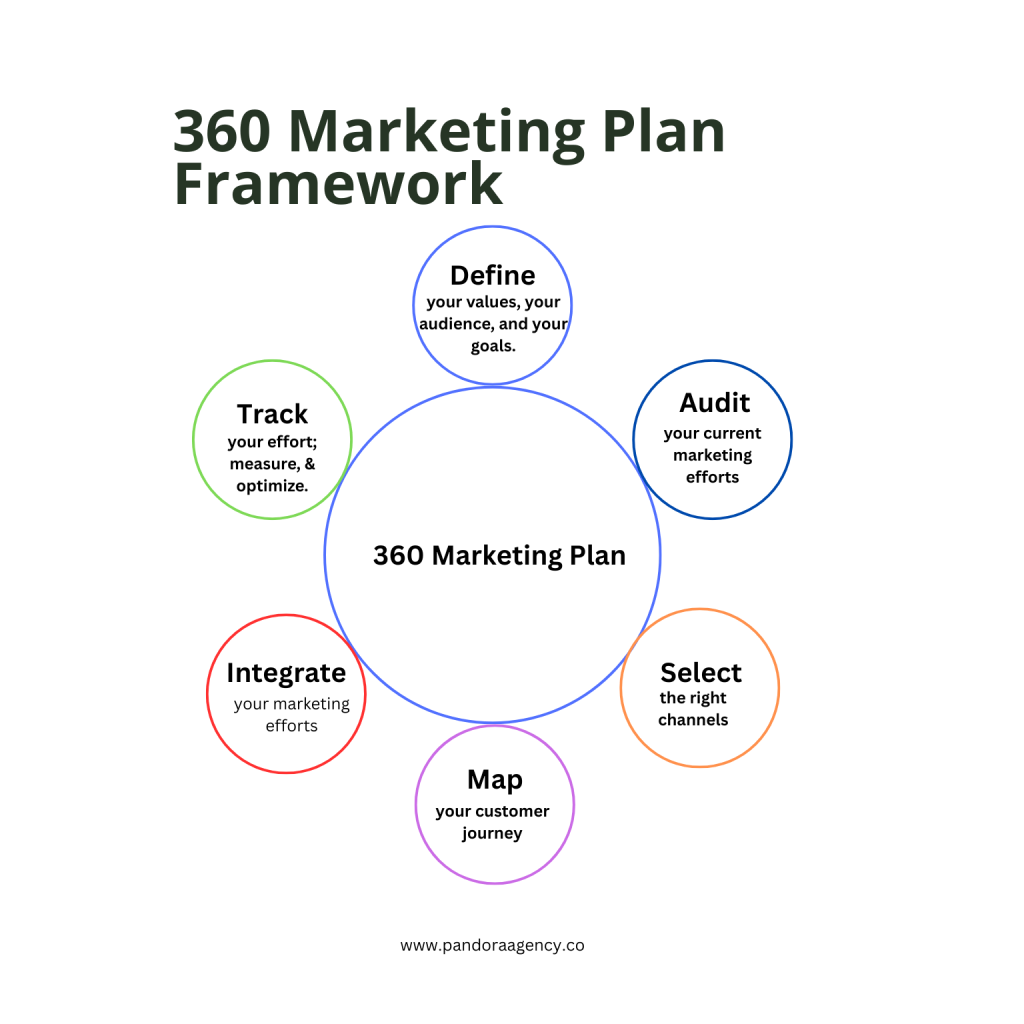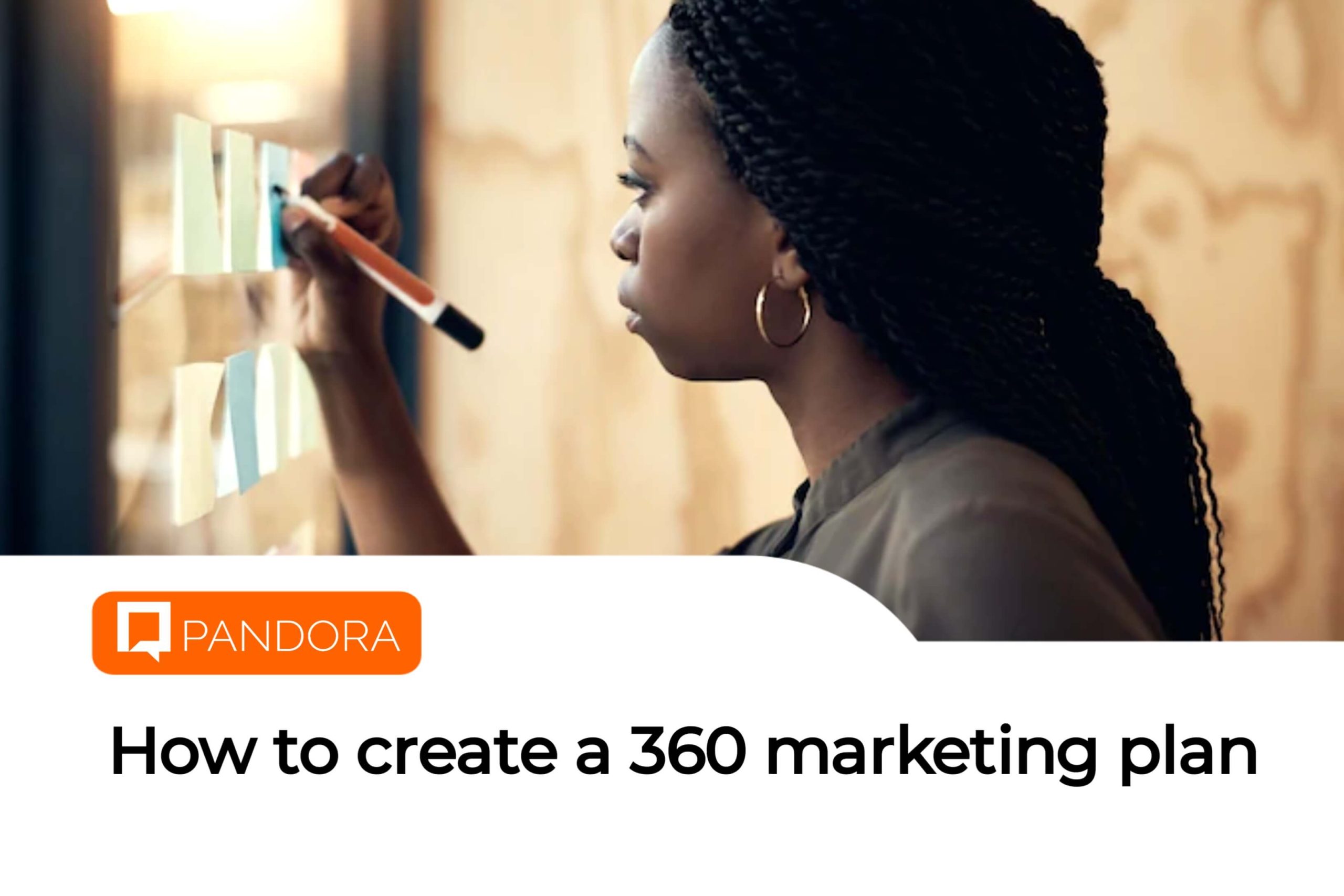In today’s fragmented media landscape, single-channel marketing strategies no longer suffice. You can’t be selling online and ignoring offline.
Likewise, you might have to integrate different online platforms and messaging formats to win your customers wherever they are.
According to HubSpot research, companies using three or more channels in their campaigns earn a 287% higher purchase rate than those using single-channel campaigns. This is what a 360° marketing plan takes care of.
A 360° marketing plan coordinates your brand’s messaging across all digital and traditional customer touchpoints to create a cohesive experience. This comprehensive approach ensures your message reaches the right audience at the right time through the best channels.

6 Steps to Creating a 360 Marketing Plan
1. Define Your Brand and Set Clear Goals
Before launching any marketing initiative, establish your brand foundation by clearly knowing your audience, your identity, and your goals.
Here’s how to go about it:
- Identify your target audience: Define key demographics and psychographics, and create detailed buyer personas. Defining your buyer persona helps you understand who you’re selling to.
Research from Salesforce shows that 76% of consumers expect companies to understand their needs and expectations. - Establish brand elements: Articulate your value proposition, brand voice, visual identity, and core messaging. According to research, consistency across channels increases revenue by 23% on average.
- Set SMART goals: Create goals that are specific, measurable, achievable, relevant, and time-bound. Here’s an example: “Increase qualified leads by 15% within 3 months through enhanced content marketing and paid social campaigns.”
2. Audit Your Current Marketing Performance
Evaluate existing initiatives before planning new ones. For each active channel, assess the following:
- Conversion rates
- Engagement metrics
- Return on investment
- Content performance
- Customer acquisition cost
Use tools like Google Analytics, social media insights, and CRM data to find out what’s working and what isn’t. Research shows that companies using marketing analytics are 1.5 times more likely to achieve above-average growth rates.
3. Select the Right Marketing Channels
Choose channels based on your audience’s preferences and behaviours, not necessarily where you have accounts.
- B2B audience: Typically engages with email marketing, LinkedIn, whitepapers, and webinars
- B2C audience: Often responds to Instagram, TikTok, YouTube, and influencer partnerships
- Gen Z: Spends 4.5+ hours daily on social media, with TikTok, Instagram, and YouTube being primary platforms
Prioritise channels where data confirms your audience is most active and receptive.
4. Map the Customer Journey
Design your marketing to guide customers through their decision-making process:
- Awareness: Make first impressions through SEO, social media, PR, and paid advertising
- Consideration: Engage them through content marketing, email nurturing, and retargeting
- Decision: Convert through product demos, testimonials, and free trials
- Retention: Build loyalty through customer service, exclusive offers, and community.
- Advocacy: Encourage referrals through loyalty programs and feedback loops
Harvard Business Review research shows that companies excelling at journey management achieve 50% higher customer satisfaction scores.
5. Integrate All Marketing Efforts
Ensure consistency across channels to create a seamless brand experience. Here’s how you can achieve that:
- Maintain consistent visual identity, messaging, and tone
- Coordinate campaign timing and themes across platforms
- Create complementary content that drives users between channels
According to Gartner, integrated marketing campaigns can improve effectiveness by 15-20%.
6. Track, Measure, and Optimize
Implement robust measurement practices to know what is truly working. Here’s how you can achieve that:
- Set up cross-channel attribution tracking
- Monitor KPIs aligned with your SMART goals
- Analyse customer journey touchpoints
- Test and refine messaging, creative, and channel mix
Research shows that data-driven marketers are 3x more likely to report competitive advantage in customer engagement and loyalty.
Key Takeaway
A well-executed 360° marketing plan ensures message consistency and audience resonance across all touchpoints. By defining clear goals, understanding your audience, selecting appropriate channels, and continuously measuring performance, you create a cohesive strategy that builds brand awareness, drives engagement, and generates measurable results.
Remember that effective 360° marketing is an ongoing process of refinement based on data-driven insights. Whether you’re launching a startup or scaling an established business, this structured approach will help you maximize marketing effectiveness and ROI.
FAQs
What is 360 marketing?
A 360 marketing campaign is an integrated strategy that delivers a brand’s message across multiple digital and traditional platforms to ensure a consistent experience at every customer touchpoint. It focuses on meeting the audience where they are, using a mix of content, channels, and timing to guide them from awareness to purchase and advocacy. The aim is to stay top-of-mind and build trust by showing up consistently and meaningfully throughout the buyer’s journey.
What does a 360 marketing plan include?
A 360 marketing plan includes clear brand goals, a defined target audience, and selected marketing channels tailored to where that audience is most active. It audits current efforts, maps the full customer journey from awareness to loyalty, and integrates all activities to ensure message and visual consistency. It also involves continuous measurement and optimization using data and performance metrics, making it a living strategy that adapts to what works.
What is an example of a 360 marketing campaign?
Company A launched a new product. They create awareness through social media and online ads, build interest with email campaigns and blog content, and drive conversions via product demos and special offers.
After purchase, they focus on loyalty through follow-up support and encourage referrals with user-generated content and rewards.
Every message is aligned, every platform connected, creating a full-circle experience that engages customers from first impression to brand advocate.






Leave a Reply